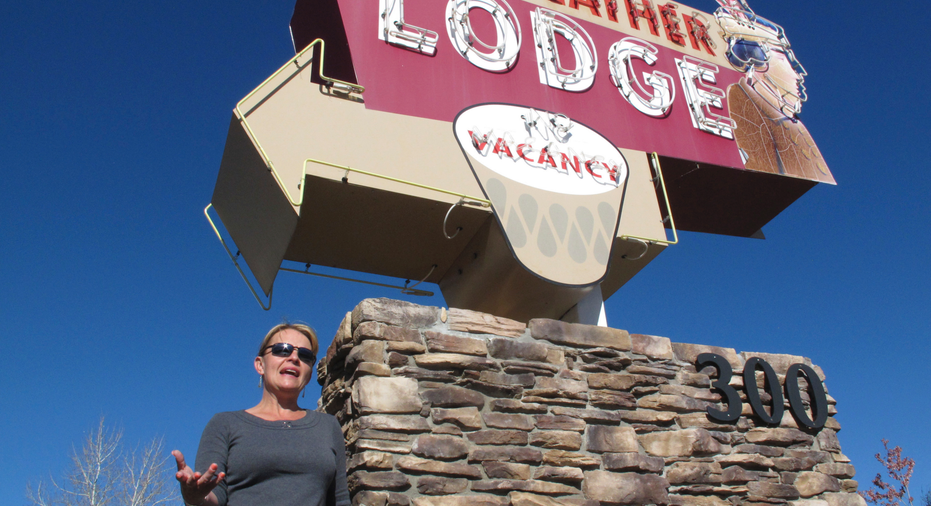Town near Grand Canyon considers push for taller buildings

TUSAYAN, Ariz. – Seconds after rounding the highway curve on the final stretch to the Grand Canyon's South Rim entrance, the first sign appears: Yes on 400. Housing. Jobs. Independence.
The ballot measure being decided Tuesday is the latest push in a decadeslong effort to build new hotels, boutique shops and commercial centers in Tusayan, a tiny town that millions of people pass through on the way to the Grand Canyon each year.
A simple majority of 262 registered voters will decide the all mail-in election that could have huge consequences for the landscape and skyline surrounding one of the most-visited national parks in the country. An Italian real estate developer is a major landowner in town and wants to change the law to raise the maximum building height to 65 feet (20 meters), clearing the way for a hotel development and other businesses.
Supporters say the ordinance is a critical step to bolster tourism and jobs in Tusayan by making it more of a destination than a quick stop on the way to the natural wonder.
"It's going to allow us to capture the visitor for longer than six hours," Vice Mayor Becky Wirth said. "We would like them to stay more than a night."
Opponent Clarinda Vail says she worries about the effect on water, traffic to the Grand Canyon and a skyline whose buildings could approach treetops and be visible from the North Rim.
"Love your Legacy," one of her campaign signs read, pointing to the area's history as a promoter — not a detractor — of the canyon, she says.
Vail's family settled Tusayan in the 1930s as cattle ranchers. Her family made a deal with Arizona in the 1950s to run Highway 64 through their property as more visitors traveled to the Grand Canyon. Their Red Feather Lodge still stands along the roadway, and the family owns other businesses and leases property.
Another major landowner, Elling Halvorson, counts a hotel and restaurant among his business ventures but is more widely known for air tours over the Grand Canyon. Among his business partners is Italy-based Stilo Development Group USA, and they are leading the effort to raise building heights.
They pushed for the vote after the U.S. Forest Service rejected access for development on Stilo's two large properties in town. No longer able to build out, Halvorson and Stilo made a move to build up at an existing RV park they own.
The two were not always on the same side.
Halvorson opposed a Stilo project in the 1990s called Canyon Forest Village, a partnership with the Grand Canyon that included a land swap with the Forest Service. It would have meant most visitors would travel into the park via light rail, but voters overturned the project.
When the RV park became available in the early 2000s, Stilo and Halvorson partnered to buy the land, Stilo spokesman Andy Jacobs said.
Incorporating the community as a town in 2010 became the way to move development on Stilo's other properties forward. Tusayan later approved annexation and rezoning agreements, but none of it came without a fight. There were lawsuits, allegations of voter fraud and intimidation, costly campaigns and bitterness among residents.
"Not a lot of developers would have taken the beating they did with Canyon Forest Village and come back 20 years later," Jacobs said. "They're committed to figuring this out one way or another."
In the short time Tusayan has existed as a town, the seats on the Town Council mostly have been held by Halvorson employees.
Some residents declined to talk about the building height increase, for fear of their jobs.
Beltsasar Gomez, breaking down Halloween decorations after a trick-or-treat event last week, quickly summed up his support: "Growth, opportunity. It's what they say. Homes, more employment, housing. This place has been too small for many years."
Ann Wren, who was part of the committee that approved current building heights, said anything higher would be detrimental to the Grand Canyon.
"They want the height increase because they want density," says Wren, a hotel owner. "Why change the rules now for the good of one organization, one party?"
And still, the promise of homeownership remains unfulfilled in a town where land mostly is in private hands and employees live in company housing, except for a few mobile homes in the RV park. The development there would include 100 apartments available for rent, Jacobs said.
Meanwhile, the town is working on an off-grid housing development on property Stilo gave to Tusayan in exchange for rezoning and annexing its properties. Tusayan Mayor Craig Sanderson said he understands the prospect for homeownership is frustrating.
All this was new to Christy and Gary Greenwald, who have been traveling to national parks across the country since August. The Georgia couple snapped a picture in front of the sandstone sign for Grand Canyon National Park.
"I'd hate to see it turned into a mini-metropolis, but 65 feet isn't so bad," Christy Greenwald said.
Gary Greenwald drew from his work with architects in pinning the area as a horizontal expanse of land, unlike Yellowstone National Park where geysers and mountains direct the eye up. He said taller buildings would destroy the views here.
"I would say exceptionally unattractive in front of a national park," he said.



















